At the root of the Chekist Day: the history of the Russian state security services
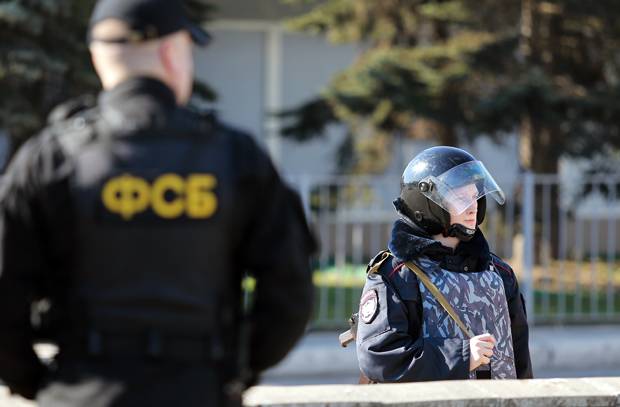
From the “thousand best servants” of Ivan the Terrible to the Separate corps of gendarmes and security departments of the Russian Empire
The beginning of the last decade of December for almost a century has been and remains festive for all employees of the state security bodies of Russia. In 1995, December 20, the first Russian president, Boris Yeltsin, signed a decree establishing a professional holiday, the Day of the Security Service of the Russian Federation. But long before this official step, the Day of the Chekist, as it was called and called by almost everyone who celebrates this date, was unofficially celebrated in all relevant divisions.
Formally, the Day of the Security Service employee is tied to the date of the creation of the first Soviet secret service - the All-Russian Emergency Commission (VChK) to combat counterrevolution and sabotage under SNK RSFSR. The decree on its creation was issued by the Council of People's Commissars 20 of December 1917. Since then, this date and became first informal, and the last two decades - an official holiday. A holiday celebrated not only by the FSB, but also by people from its predecessor, the KGB of the USSR: employees of the Foreign Intelligence Service, the Federal Guard Service, the General Directorate of Special Programs and others.
But one cannot seriously believe that before the appearance of the Cheka, there were no state security bodies in Russia! Of course, there existed - and the Chekists, whatever the Bolsheviks may say about the need to "destroy the whole world of violence", began their work not from scratch. Moreover, the continuity of the Soviet special services in relation to the Russian was clearly emphasized from the very first day! After all, the 2 house on Gorokhovaya Street became the place of deployment of the Cheka in Petrograd — that is, the same house in which the Petersburg Branch for the Preservation of Public Security and Order housed the 4 in March 1917. Yes, yes, that same Security Department, which revolutionaries contemptuously called “secret service”, but whom they were afraid of like fire ...
"A thousand of the best servants" on guard of the Moscow kingdom
As soon as a state arises, it immediately becomes necessary to take care of its security. This axiom was well understood in the era of antiquity, and over time it found more and more new evidence. Accordingly, the more complex the state structure of the country was, the more difficult the system of its security organs became. The idea of several special services, which allow the head of state to receive more complete and objective information due to their competition, was born far from the 20th century, but much earlier!
As for Russia, the famous “thousand best servants” can be considered the prototype of domestic state security bodies, the decree on the creation of which Ivan IV the Terrible signed in October 1550 of the year. In a different way, this unit was called "the Tsar and the Grand Duke of the Regiment" and consisted of 1078 boyar children. At the same time, a special Streltsy regiment was created in Moscow to guard the first Russian tsar. It was these regiments that became the first formal structures of state security, since they dealt not only with military threats to the kingdom of Moscow, but with the identification and elimination of internal threats.
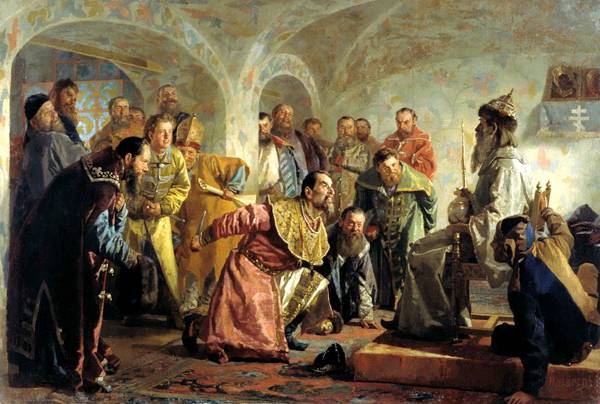
"Oprichniki." Artist - Nikolay Nevrev
When Ivan the Terrible finally turned into an autocratic ruler, the тысяч thousand best servants ’, many of whom managed to cross to the side of the enemy, fearing the royal rage, were replaced by oprichniki. But not only they were responsible for the security of Russia: part of the functions of the state security organs were entrusted to the orders created by the tsar. For example, the Bit order dealt with “thieves” and “robbery” cases (unlike the current definitions of these crimes, in the XVI century thieves and robbers were more likely under the state security department), and the Accountable was responsible for combating embezzlement from the treasury.
Alas, the uncritical Oprichnina, subordinated only to Ivan IV, could not effectively fulfill the functions of a state security body. Therefore, the epoch of Grozny’s tragic, ambiguous, but very important for the development of Russia was replaced by the notoriously Troubled Time, and only the ascension to the Russian throne of the future Emperor Peter I brought the country back to the normal path of development. Under him, the first real state security organs appeared in Russia.
Special services nest Petrova
Inheritance from his father, Tsar Alexei Mikhailovich, the future first Russian emperor received the Order of Secret Affairs created in 1653 year - according to historians, the first truly special service in the country, engaged in state security. But the far-seeing Tsar Peter from the very beginning made sure that with him several such services were responsible for state security. In particular, everything related to the activities of foreigners and the departure of Russians abroad was in charge of the College of Foreign Affairs. She, as it is not hard to guess, had to deal with the perusal of letters, and oversee the “Germans”, many of whom could be foreign spies - and in reality they were, because then such an exercise was not at all considered something shameful. And directly the internal security of the state under Peter was engaged in two structures: the Preobrazhensky order and the Secret Chancellery.
The Preobrazhensky order arose as early as 1686, and was initially in charge of managing the Transfiguration and Semenovsky regiments. Only after 1702 of the year did the king impose a duty on this order to conduct cases of “word and deed by the sovereign,” that is, crimes against state power. Therefore, the Preobrazhensky order was submitted directly to Peter I, and it was led by the famous prince Caesar Feodor Romodanovsky.
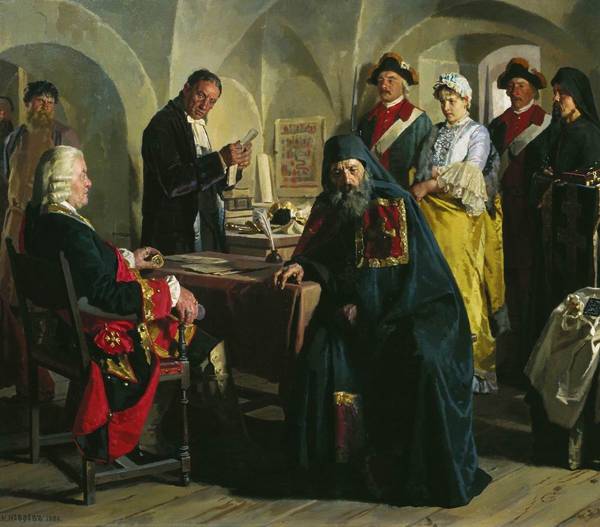
He was also entrusted by the king and the Secret Chancellery, which was created in February 1718 in Petersburg, which was initially engaged in one and only case: the consequence of the treason against Tsarevich Alexei. A little later, the office of this office, located in the Peter and Paul Fortress, was transferred from the Transfiguration of the Order and other political affairs of particular importance. And soon Peter, having decided that it was already difficult for him to manage and direct the activities of two special services at the same time, united the order and the office under one roof - the Preobrazhensky order, after the accession of Catherine I, renamed the Preobrazhenskaya office.
Her successor was created in 1731 on the ruins of the Secret Chancellery - Peter II eliminated the secret service, distributing its responsibilities between the Supreme Privy Council and the Senate - the Office of Secret and Investigation Cases. She was charged with the obligation to carry out operational development and investigation of cases of malicious acts against the sovereign and his family and against the state itself (the case of "rebellion and treason"). The Office of Secret and Investigation Affairs existed until 1762, until it was eliminated by the manifesto of Peter III. Instead, the emperor ordered the creation of a new secret service under the Senate, which was in charge of state security, the famous Secret Expedition.
Mystery as important weapon
The new special service, initially called the Special Office and changing its name already under Catherine II, inherited functions not only to ensure the internal security of the state, but also counterintelligence. And for the first time in Russian practice, the Secret Expedition introduced the practice of identifying foreign agents with the help of its own foreign employees. It was with their help that freight forwarders — namely, the so-called employees of the new service — received information about both spies and those who were recruited by them in Russia.
But still the main task of the Secret Expedition was precisely the internal security of the country. At that time, this meant uprisings and conspiracies against the government, betrayal and espionage, imposture, criticism of government policies and actions of the king, members of the royal family or representatives of the royal administration, as well as acts detrimental to the prestige of the royal power. Among the many cases that happened to lead the forwarders of the Secret Chancellery, there were such loud as the uprising of Yemelyan Pugachev and the activities of Alexander Radishchev, the author of the famous “Journey from St. Petersburg to Moscow”, the case of the mason-journalist Nikolai Novikov and the impostor Princess Tarakanova, as well as the case of the Secretary of the Board of Foreign Affairs of the court counselor Valva accused of espionage.
It is noteworthy that most of these cases were supervised, or even directly led by their investigation, the most, perhaps, famous head of the Secret Expedition - its chief secretary Stepan Sheshkovsky. During his time, as contemporaries described it, the office forwarders “knew everything that was happening in the capital: not only criminal plans or actions, but even free and careless conversations”. And his fame as the head of the Secret Chancellery was so wide and odious that, as eyewitnesses said, when Alexander Radishchev was told that Sheshkovsky would be personally involved, the writer literally collapsed into a swoon.
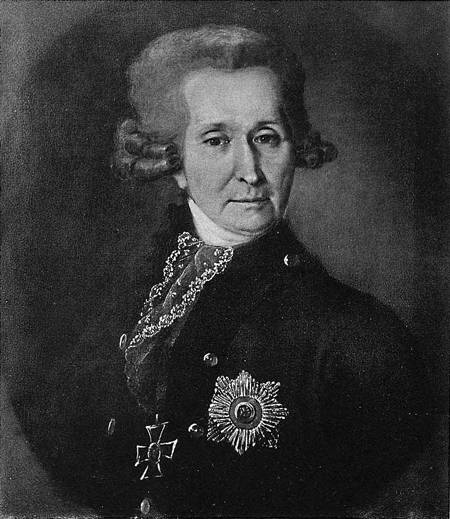
Stepan Sheshkovsky. Source: Collection of Mikhalkovs in the estate of Petrovskoe, Rybinsk district, Yaroslavl province
It is curious that Catherine II understood very well how much such a veil of fear and mystery influences the performance of such state security services. It was not by chance that the entire 2000 rubles per year were spent officially on the maintenance of the Secret Chancellery, which were spent on the payment of salaries to freight forwarders, and the real expenses on the work of the office and those instructions that she received from the Senate and directly from the Empress were kept in the strictest confidence. The location of the headquarters of the special service, in the Peter and Paul Fortress, which for a long time became a symbol of political repression in the country, contributed in no small measure to this.
The third branch as a result of the Decembrist uprising
The secret office existed until 1801, after which the decree of the new emperor Alexander I was eliminated. In the year 1807, instead of it, a Special Committee was created, which was sometimes called the Committee for the Preservation of General Security, and the Special Office working in parallel with it. First existing at the Ministry of Police, and then at the Ministry of Internal Affairs, this office was engaged, in fact, in the same way as its predecessor, unless it did not cause such irrational fear in society - and acted less decisively. As a result, she missed the preparation of the Decembrist uprising in 1825, after which Emperor Nicholas I ascended the throne.
The new autocrat immediately appreciated the benefits of the effective state security service. And soon a really active intelligence service appeared in Russia: July 3 (old style) 1826, the Special Office of the Ministry of the Interior was transformed into the Third Division of His Imperial Majesty's Office. The head of the new service was Adjutant General Alexander Benkendorf, who, ten days before, the emperor had entrusted the post of chief of gendarmes with the subordination of the Separate gendarmes corps newly created in the country.
Thus, the first real state security service appeared in Russia, possessing all the modern attributes of such a structure. She was in charge of such issues as “all orders and news on all general cases of the Supreme Police; information on the number of different sects and splits existing in the state; news of discoveries on false banknotes, coins, stamps, documents, etc., of which the search and further production remain dependent on the ministries: finance and internal affairs; detailed information about all people under police supervision consisting, as well as everything according to this order; expulsion and placement of people suspicious and harmful; observant and economic management of all places of detention in which state criminals are imprisoned; all resolutions and orders about foreigners living in Russia, arriving to and from the state boundaries; statements of any incidents without exception; statistical information related to the police. " As can be seen, the responsibilities of the Third Division, together with the Separate corps of gendarmes, practically cover all those matters that the Federal Security Service is currently engaged in.
From the Security Department - to the Cheka
In this form, the Third Division, conceived as a structure that not only protects the state from internal dangers, but also helps it to free itself from bribe takers and embezzlers - and this kind of criminals were already considered threats to state security! - existed until 1880 year. Alas, it did not achieve these goals, and therefore, in the reign of Emperor Alexander III, it was reassigned to the newly created Supreme Administrative Commission for the Preservation of State Order and Public Peace. When, after six months, this commission also ceased to exist, the Third Division was completely disbanded. In its place, the 3-s office work of the State Police Department (later - just the police) of the Ministry of the Interior of Russia arose.
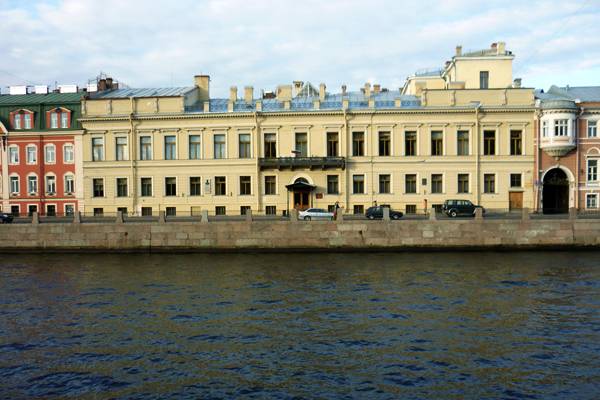
The headquarters building of the Separate gendarme branch, where, after 1838, the Third compartment was located, on the Fontanka embankment. Photo: wikipedia.org
The successor of the Third Division, who even retained his number, was called “secret clerical work of the Police Department” until 1898, and engaged in a political search (that is, oversight of political organizations and parties and the fight against them, as well as with the mass movement). This process was internal and foreign agents and was in charge of the protection of the emperor and high dignitaries. Actually, the main tools of the Third Office work were security offices - the very same secret police.
Interestingly, the security departments themselves arose significantly earlier than the structure to which they ultimately were subordinate. The first such department appeared in St. Petersburg in 1866, after the first attempt on the life of Emperor Alexander II. It was called the Department for the production of affairs for the preservation of public order and peace in St. Petersburg. The second in November 1880 of the year was the Moscow Security Department, and the third - the Warsaw.
In December, 1907, throughout Russia, there were 27 security offices - and this was the peak figure. After the revolutionary activities of 1905 – 1907 have gradually come to naught, and the revolutionaries have chosen to organize the working class to fight from outside the country (since then it has generally become a tradition of the domestic opposition — it’s safer and, more importantly, more comfortable) the number began to decline again, and by the year 1917 there were only three Security Offices left in Russia: those of Warsaw, Moscow and St. Petersburg. The location of the latter was precisely the very same 2 house on Gorokhovaya Street, where the first Soviet intelligence service to ensure state security, the famous Cheka, had settled on 20 on December 1917.
Chronology of the state security bodies of the USSR and the Russian Federation
20 декабря 1917 года
By the resolution of the Council of People's Commissars to fight counter-revolution and sabotage in Soviet Russia, an All-Russian Emergency Commission (VChK) was formed to combat counter-revolution and sabotage under SNK RSFSR. Felix Dzerzhinsky was appointed its first chairman.
6 February 1922 year
Read under "History»
"And the battle was great and the battle was evil ..." December 22 of 1317, the battle of Bortene was fought "And there was a great battle and the battle was evil ..."
The All-Russian Central Executive Committee adopted a resolution on the abolition of the Cheka and the formation of the State Political Administration (GPU) under the NKVD of the RSFSR.
November 2 1923 years
The Presidium of the CEC of the USSR created the United State Political Administration (OGPU) under the SNK of the USSR.
July 10, 1934
In accordance with the decision of the USSR Central Election Commission, the state security organs entered the People's Commissariat of Internal Affairs (NKVD) of the USSR under the name of the Main Directorate of State Security (GUGB).
3 February 1941 year
The NKVD of the USSR is divided into two independent bodies: the NKVD of the USSR and the People's Commissariat of State Security (NKGB) of the USSR.
July 20, 1941
The NKGB of the USSR and the NKVD of the USSR are again united into a single people's commissariat - the NKVD of the USSR.
April 14 1943 years
The newly formed People's Commissariat of State Security of the USSR.
15 March 1946 year
NKGB reorganized into the Ministry of State Security.
5 March 1953 year
It was decided to merge the Ministry of Internal Affairs and the Ministry of State Security into a single Ministry of Internal Affairs of the USSR.
13 March 1954 year
The State Security Committee at the Council of Ministers of the USSR was established.
6 May 1991 years
Chairman of the Supreme Council of the RSFSR Boris Yeltsin and Chairman of the USSR KGB Vladimir Kryuchkov signed a protocol on education in accordance with the decision of the Congress of People's Deputies of Russia of the State Security Committee of the RSFSR.
November 26 1991 years
The first president of Russia, Boris Yeltsin, signed a decree on the transformation of the KGB of the RSFSR into the Agency of the Federal Security of the RSFSR.
3 декабря 1991 года
USSR President Mikhail Gorbachev signed the law "On the reorganization of state security agencies." On the basis of this law, the KGB of the USSR was abolished, and on its basis, the Inter-republican Security Service (SME) and the Central Intelligence Service of the USSR (currently the Foreign Intelligence Service of the Russian Federation) were created for the transition period.
January 24 1992 years
Boris Yeltsin signed a decree on the formation of the Ministry of Security of the Russian Federation on the basis of the abolished AFB RSFSR and SME.
21 декабря 1993 года
Boris Yeltsin signed a decree abolishing the Russian Ministry of Internal Affairs and creating the Federal Counterintelligence Service (FGC) of the Russian Federation.
April 3 1995 years
Boris Yeltsin signed the Law “On the Bodies of the Federal Security Service in the Russian Federation”, on the basis of which the FSB is the successor of the FGC.
Information